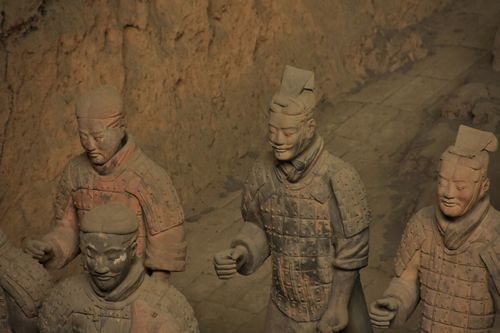
Emperor Qin's Terracotta Army: Silent Guardians of Eternity
About Emperor Qin's Terracotta Army
Deep beneath the earth, in the shadow of the First Emperor's mausoleum, lies an army frozen in time. This is the Terracotta Army, a vast collection of life-sized clay soldiers, chariots, and horses, created to serve and protect China's first emperor, Qin Shi Huang Di, in the afterlife. This UNESCO World Heritage site offers a glimpse into the power, ambition, and artistry of ancient China.
The Life and Reign of Qin Shi Huang Di
Born Ying Zheng in 259 BCE, Qin Shi Huang Di ascended the throne of the Qin state at the tender age of 13. A ruthless and ambitious ruler, he unified the warring states of China by 221 BCE, ending centuries of conflict. He proclaimed himself "Qin Shi Huangdi" – the First Emperor of Qin – and established a centralized empire that laid the foundation for China's future.
The Purpose of the Terracotta Army
The First Emperor was obsessed with immortality and sought to recreate his earthly power in the afterlife. He envisioned a vast necropolis, a city of the dead, with the Terracotta Army as his loyal protectors. Each warrior was meticulously crafted with unique features, reflecting the diversity of his vast empire.
The Creation and Discovery of the Army
The construction of the Terracotta Army was a monumental undertaking, employing hundreds of thousands of laborers and artisans for nearly 40 years. Using local clay, skilled craftsmen molded and fired each figure, paying close attention to detail, from their armor and weaponry to their individual expressions.
The army lay forgotten for centuries until 1974, when farmers digging a well stumbled upon fragments of terracotta figures. This accidental discovery sparked one of the most significant archaeological excavations of the 20th century, revealing the full scale and grandeur of the First Emperor's necropolis.
The Army's Composition and Significance
The Terracotta Army is arranged in battle formations, reflecting the military might of the Qin dynasty. Thousands of soldiers, each with distinct facial features, hairstyles, and armor, stand ready to defend their emperor. Chariots pulled by teams of life-size horses add to the impressive display.
The army's significance extends beyond its sheer scale. It provides invaluable insights into ancient Chinese military tactics, weaponry, and craftsmanship. The individual features of each soldier offer a glimpse into the diversity of people within the Qin empire.
Did the Terracotta Army Accompany Qin Shi Huang Di in Death?
While the Terracotta Army was built to serve the First Emperor in the afterlife, they were not buried with him in the main tomb. The soldiers, chariots, and horses were interred in vast underground pits located approximately 1.5 kilometers east of the emperor's still-unexcavated burial mound.
FAQs
Q: How many Terracotta Warriors are there?
A: It is estimated that over 8,000 life-size terracotta figures, including warriors, chariots, and horses, are buried within the three pits of the Terracotta Army.
Q: Are any of the Terracotta Warriors the same?
A: No, each Terracotta Warrior is unique, with individual facial features, hairstyles, and clothing details, showcasing the artistry and skill of the Qin dynasty craftsmen.
Q: Why hasn't the tomb of Qin Shi Huang Di been excavated?
A: Out of respect for the emperor and concerns about preserving the delicate artifacts within, the Chinese government has chosen to postpone the excavation of the main tomb.